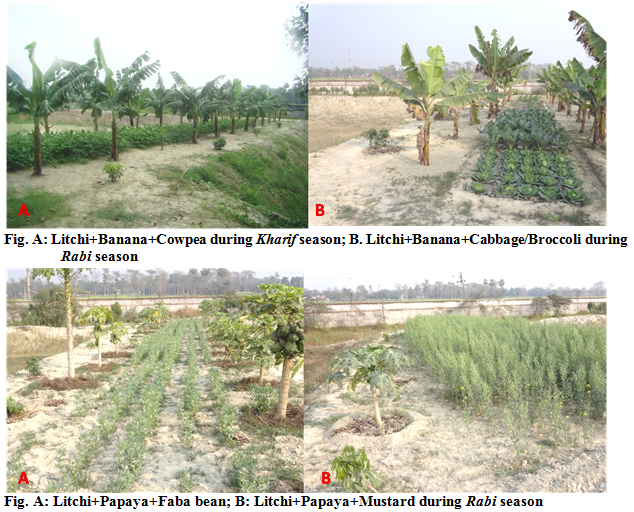Authors: R.K. Patel, S.D. Pandey, S.K. Purbey, Amrendra Kumar, Kuldeep Srivastava and Vishal Nath
ICAR-National Research Centre on Licthi, Muzaffarpur, Bihar, India
Introduction
A substantial area of the country is under wastelands in the form of permanent and seasonal waterlogged, marshy land condition. The major problems associated with this wasteland are poor drainage and high rains during monsoon months resulting in deep water-logging of cultivated field. Some parts of Bihar remain waterlogged (> 1m surface water-logging) for 4-5 months and become unproductive during these months. The harvesting of excess water can be done effectively through suitable shaping of the farm land, which involves in modifying the surface of the farm land for conservation of excess rain water and making the land surface suitably shaped for successful cultivation of litchi along with other fruit and seasonal crops on pond dyke and fisheries in pond through integrated approach of farming system. To stabilize and enhance net income from such low lying waterlogged ecosystem, litchi based cropping in pond based production system (litchi+ banana+seasonal crops (vegetables)/litchi+papaya+seasonal crops on pond dyke + fish inside pond) was conceptualized and implemented in representative deep low lying areas (1.5-2.5 m water depth).
Methodology
The waterlogged low land area was converted into pond of about 2.5-3 m depth. The dug out soil was used to form high land pond dyke of 10-12 m width during creation of pond. The pond dykes were used for growing of multiple and diversified crops throughout the year with litchi+banana and litchi+papaya combinations. The ponds were used for rainwater harvesting for irrigation purpose during lean period and for fish culture. The cropping system on pond bunds includes three tier model of litchi cum banana/papaya and seasonal crops based system comprised with 5 models (Bund I: Two row of litchi & banana + vegetables, Bund II: Two row of litchi & papaya + annual crop, Bund III: Two row of litchi + banana in between two litchi plants + annual crop, Bund IV: Two row of litchi + papaya in between two litchi plants + annual crop and Bund V: Two rows of litchi).
Outcome
Performance of different fruits and seasonal crops grown with litchi based cropping system on pond bunds sowed that banana cv. Grand Naine recorded average bunch weight of 19.12 kg/plant with average yield 41.0 t/ha. Papaya cv. Pune Selection-3 recorded fruit yield of 8-10 kg/plant with average yield of 18.2 t/ha and 0.92-1.25 kg fruit weight. Cowpea cvs. Kashi Nidhi performed better with average yield of 14.53 t/ha and maize cob yield of 3.88 t/ha during Kharif season. Potato and cole crops were taken during Rabi season in model I, faba bean in model II, maize in model III and mustard in model IV. The highest yield was recorded in cabbage (26.36t/ha) followed by knol khol (19.66t/ha) and potato (13.4t/ha). The average grain yield in faba bean was recorded 2.37q/ha, in maize (green cob) 16.2t/ha and in mustard 2.5t/ha under different models.
Conclusion
On the basis of overall economic analysis of different models, the highest average net return was obtained with banana+cowpea-cabbage in model I (Rs 10.76/m2) followed by banana+maize (Rs 6.55/m2) in model III and papaya+faba bean (Rs 5.84/m2) in model II.

About Author / Additional Info:
Scientist fruit science working on litchi based cropping system, organic farming of litchi, and plant propagation and nursery management of fruits